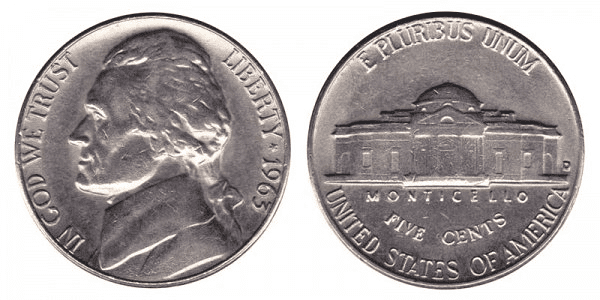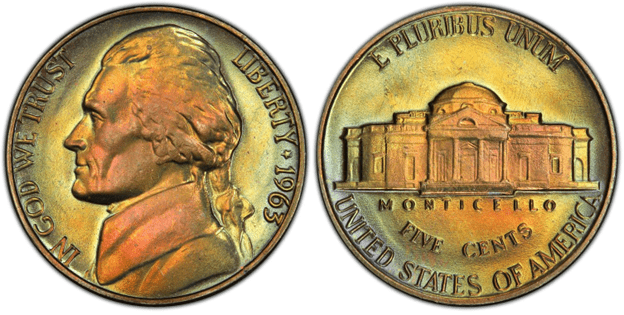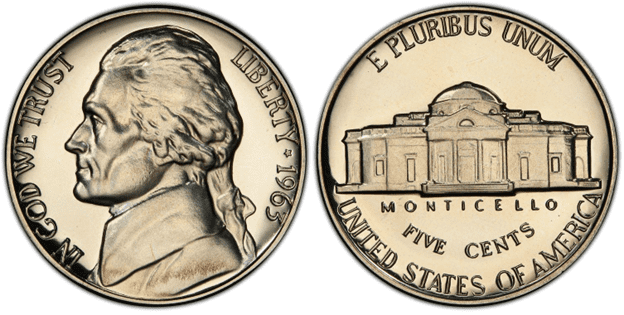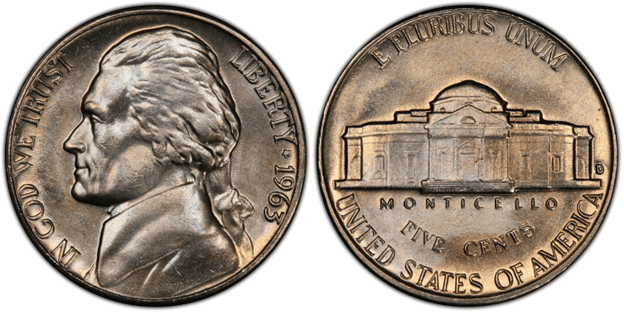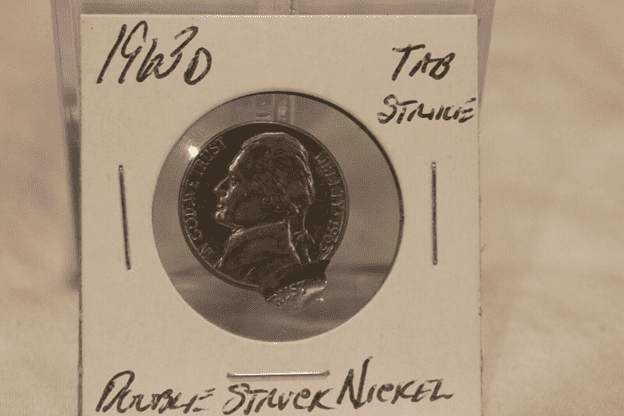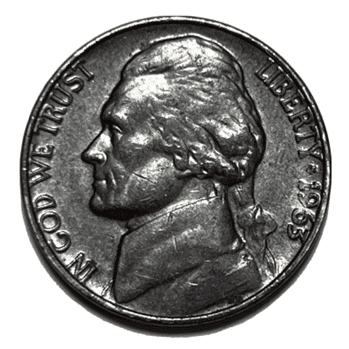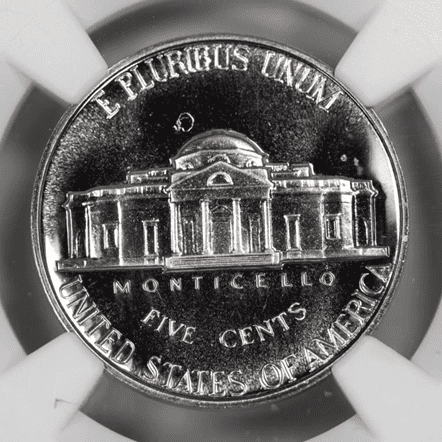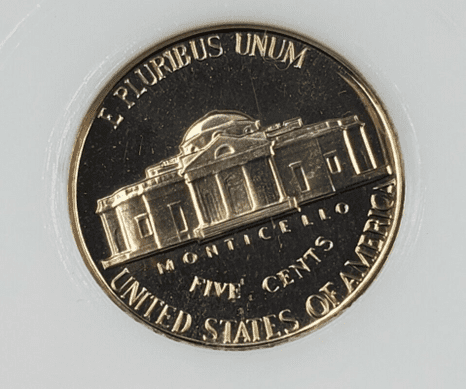What Is the 1963 Jefferson Nickel Made Of?
The 1963 Jefferson nickel is made of 75 percent copper and 25% nickel. It has a value of 5 cents ($0.05), a mass of 5 grams, a diameter of 21.21 millimeters, and a plain edge. From mid-1942 to 1945, the Jefferson nickel was made of 56 percent copper, 35 percent silver, and 9 percent manganese.
The Jefferson nickel was first struck in 1938, replacing the hard-to-produce buffalo nickel. The US Mint always wanted to change the design of the buffalo nickel because of how easily its die would break.
After 25 years of using the buffalo nickel, the US Mint held a design competition. Felix Schlag’s design was chosen. Although he needed to do a few revisions, his design has been used from 1938 to 2004. In 2005, after more than six decades, Schlag’s design was replaced by the new design made by Jamie Franki.

photo source: USA Coin Book
As its name suggests, the 1963 nickel bears the left profile of Thomas Jefferson, one of the Founding Fathers of the United States and the third president of the country.
On the obverse, inscriptions include 1963, LIBERTY, and IN GOD WE TRUST.
On the reverse, you’ll find the Monticello Mansion, designed and built by Jefferson as well. Inscriptions include E PLURIBUS UNUM, FIVE CENTS, and UNITED STATES OF AMERICA.
1963 Jefferson Nickel Varieties
For the 1963 Jefferson nickel, there are three standard varieties. These are the 1963 P Jefferson nickel, 1963 P Jefferson proof nickel, and 1963 D Jefferson nickel. Today, proof coins are produced in the San Francisco Mint. However, in 1963, it was the Philadelphia Mint that created the proof nickels.
The 1963 proof coins were made for collectors. Philadelphia-proof coins were first struck in 1950 up until 1964. The proof coin production from Philadelphia was discontinued due to a coin shortage. The proof coin production was then resumed in 1968, but this time, the San Francisco Mint took over.
Aside from the standard varieties of the 1963 Jefferson nickels, there are also those that have errors with them.
Here are the 1963 Jefferson nickel varieties that you should know:
1963 P Jefferson nickel
Edge: Smooth
Mint Mark: No mint mark
Place of minting: Philadelphia
Year of minting: 1963
Face Value: $0.05 (fifty cents)
Price: $0.05 to $3.00 (or more)
Quantity produced: 175,784,000
Designer: Felix Schlag
Composition: 75% copper and 25% nickel
Mass: 5 grams
Diameter: 21.21 mm
Thickness: 1.95 mm

photo source: PCGS
The 1963-P Jefferson nickel was struck in the Philadelphia Mint. There’s no mint mark and the average price ranges from $0.05 to $3.00.
There are more than 175 million 1963-P Jefferson nickels, making this coin a common coin. You can even find some of them in circulation today. Most circulated coins may not be in good condition anymore. Thus, you’ll find only a few MS-63 1963-P Jefferson coins.
Higher grades such as MS-65 are more difficult to find. Nevertheless, MS-65, MS-66, and MS-67 exist but they are a lot more scarce than others. “Full Steps” 1963-P nickels are also valuable.
1963 P Jefferson nickel (proof)
Edge: Smooth
Mint Mark: No mint mark
Place of minting: Philadelphia
Year of minting: 1963
Face Value: $0.05 (fifty cents)
Price: $0.05 to $7.00 (or more)
Quantity produced: 3,075,645
Designer: Felix Schlag
Composition: 75% copper and 25% nickel
Mass: 5 grams
Diameter: 21.21 mm
Thickness: 1.95 mm

photo source: PCGS
The 1963-P proof Jefferson nickel was also struck in the Philadelphia Mint. The mint mark is absent. The average price ranges from $0.05 to $7.00, which is higher considering that these coins are proof.
Proof coins are more difficult to produce. It takes more time as well. The reason is that proof coins are more detailed, have a better shine, and have better eye appeal. Moreover, proof coins are made for collectors and not for circulation.
Thus, you will see that only more than 3 million of 1963-proof nickel coins were issued, which is far fewer than the huge number of standard-struck nickels.
1963 D Jefferson nickel (proof)
Edge: Smooth
Mint Mark: D
Place of minting: Denver
Year of minting: 1963
Face Value: $0.05 (fifty cents)
Price: $0.05 to $16.00 (or more)
Quantity produced: 276,829,460
Designer: Felix Schlag
Composition: 75% copper and 25% nickel
Mass: 5 grams
Diameter: 21.21 mm
Thickness: 1.95 mm

photo source: PCGS
The 1963-D proof Jefferson nickel was struck in the Denver Mint. You’ll find the “D” mint mark on the right side of the Monticello image. The average price ranges from $0.05 to $16.00, which is the highest among the standard-issued nickels in 1963.
Aside from that, the 1963-D Jefferson nickel has the highest mintage, which is more than 276 million. This makes 1963-D nickels to be the most abundant variety of nickel for that year.
List Of 1963 Jefferson Nickel Errors
Errors do happen when minting the 1963 Jefferson nickel. With millions upon millions of nickels struck, there’s always a possibility that error coins would come out from the minting centers.
Although errors may sound like a negative thing, many collectors are actually happy to collect them. Coin errors are always interesting because of how random minting errors can make a coin unique and rare.
There are different reasons for coin errors to happen and each reason would lead to a different type of error.
Here’s an example:

photo source: eBay
This 1963-D Jefferson nickel was struck twice. The second strike even deformed the coin and added the word “TRUST” in the 5 o’clock direction. This is a rare error and thus, this coin can be sold for a few more dollars.
Sometimes, the coin is improperly annealed, giving the coin a different color. Here’s an example where the coin becomes dark:

photo source: eBay
There are instances as well when a foreign material comes between the die and planchet. This foreign material can be grease, metal dust, and others.
In this image, you can see that there’s a little circle on top of the Monticello dome. It was caused by the die striking through a foreign material.

photo source: eBay
Another interesting error is the rotated die error. This happens when one side has the right angle while the other side is struck at a different angle. So, if you look at both sides of the coin, you’ll see that there’s a difference in their angle of strike.
Here’s an example of a rotated die:

photo source: eBay
How Much Is 1963 Jefferson Nickel Worth Today?
The normal 1963 Jefferson nickel isn’t that valuable. Its value is the same as its face value, which is $0.05. The melt value is $0.0570.
Nevertheless, there are still 1963 Jefferson nickels that are worth a lot of money. Usually, the more expensive 1963 Jefferson nickels are the ones that have been appraised and have received a high grade.
To help you get a better idea of the prices, here’s a 1963 Jefferson Nickel values chart:
| Coin | Condition | Grade | Mintage | Value |
| 1963 P Jefferson Nickel | Circulated/mint | Not graded | 175,784,000 | $0.05 to $3.00 |
| 1963 P Jefferson Nickel | Uncirculated/mint | MS-65 | 175,784,000
|
$312 to $432 |
| 1963 P Jefferson Nickel | Uncirculated/mint | MS-66 | 175,784,000
|
$852 to $1,704 |
| 1963 P Jefferson Nickel | Uncirculated/mint | MS-67 | 175,784,000
|
$1,500 to $3,600 |
| 1963 P Jefferson Nickel (Proof) | Uncirculated/proof | Not graded | 3,075,645 | $0.05 to $7.00 |
| 1963 P Jefferson Nickel (Proof) | Uncirculated/proof | MS-67 | 3,075,645 | $11 to $39 |
| 1963 P Jefferson Nickel (Proof) | Uncirculated/proof | MS-68 | 3,075,645 | $16 to $45 |
| 1963 P Jefferson Nickel (Proof) | Uncirculated/proof | MS-69 | 3,075,645 | $24 to $60 |
| 1963 D Jefferson Nickel | Circulated/mint | Not graded | 276,829,460 | $0.05 to $16.00 |
| 1963 D Jefferson Nickel | Uncirculated/mint | MS-65 | 276,829,460
|
$16 to $81 |
| 1963 D Jefferson Nickel | Uncirculated/mint | MS-66 | 276,829,460
|
$45 to $517 |
As you can see, there are still 1963 nickels that are worth hundreds and even thousands of dollars. Based on the table, the most expensive nickel is the 1963 P Jefferson nickel. It was determined to be a full-step nickel and has a grade of MS-67. It was sold for $3,600 during a Heritage Auction in Orlando that was held in January 2022.
How Does The Grading System Work?
The Sheldon Scale is used by numismatists to provide a numerical value to coins. The Sheldon Scale goes from poor (P-1) to perfect mint state (P-1) (MS-70). Coins were originally evaluated using words to reflect their condition (Good, Fair, Excellent, Etc.). Unfortunately, coin collectors and dealers had different ideas about what each of these terms represent.
Professional numismatists joined together in the 1970s and established CoinGrading standards. These numismatists now assign grades at key places on the seventy-point scale, using the most regularly utilized numeric points in conjunction with the original adjective grade. The following are the most common coin grades:
-
-
- (P-1) Poor – Indistinguishable and probably damaged; if used, must have a date and mintmark; otherwise, rather battered.
- (FR-2) Fair – Nearly smooth, but without the damage that a coin graded Poor often possesses. The coin must have enough detail to be identified.
- (G-4) Fair – Inscriptions have merged into the rims in some areas, and important elements have been mostly erased.
- (VG-8) Very Good- A little weathered, but all of the primary design elements are visible, albeit faintly. There is little if any, central detail left.
- (F-12) Good – The item is very worn, yet the wear is even, and the overall design details stand out clearly. Rims are almost completely isolated from the field.
- (VF-20) Very Fine – Moderately weathered, with some finer features still visible. The motto or all letters of LIBERTY are readable. Both sides of the coin have entire rims that are separated from the field.
- (EF-40) Extremely Fine – Gently used; all gadgets are visible, and the most important ones are bold. The finer details are bold and clear, however, light wear may be seen.
- (AU-50) Uncirculated – Slight evidence of wear on the coin’s design’s high points; may have contact marks; eye appeal should be adequate.
- (AU-58) Uncirculated Choice – Slight traces of wear, no severe contact marks, almost full mint shine, and great eye appeal.
- (MS-60) Mint State Basal – Strictly uncirculated; no indication of wear on the coin’s highest points, but an unsightly coin with reduced luster, visible contact marks, hairlines, and other flaws.
- (MS-63) Mint State Acceptable – Uncirculated, but with contact scratches and nicks, little reduced shine, but otherwise appealing appearance. The strike is weak to average.
- (MS-65) Mint State Choice – Uncirculated with great mint shine, very little contact blemishes, and exceptional eye appeal. The strike is unusually severe.
- (MS-68) Mint State Premium Quality – Uncirculated with superb luster, no obvious contact marks to the naked eye, and exceptional eye appeal. The strike is quick and appealing.
- (MS-69) Almost Perfect Mint State – Uncirculated with perfect brilliance, a sharp and appealing strike, and extremely good eye appeal. A near-perfect coin with minor imperfections in the planchet, strike, and contact markings (seen only under 8x magnification).
- (MS-70) Mint State Perfect – Under 8x magnification, there are no tiny imperfections discernible; the strike is crisp, and the coin is perfectly centered on a beautiful planchet. Rarely seen on a coin, this coin is bright and whole, with original luster and exceptional eye appeal.
-
Where To Buy Or Sell 1963 Jefferson Nickel?
The best place to buy or sell 1963 Jefferson nickels would be on the Internet. In this modern day, you can easily find the coins that you’re interested in with just a simple push of a button. You don’t even need to leave your home just to buy or sell your coins.
Some of the most popular websites where you can buy or sell a 1963 Jefferson nickel would be on eBay, Amazon, and Etsy. Creating an account is free, so you can quickly start buying and selling coins.
Aside from the Internet, you can buy 1963 Jefferson nickels in antique stores, coin shops, and auction houses. You can also contact private collectors who might be interested in buying your coins or selling their coins to you.
FAQs
Is there anything special about a 1963 nickel?
The 1963 nickel becomes a special coin when they have a high grade and are still in good condition.
How do I know I have a black beauty 1963 nickel?
The black beauty 1963 nickel is a rare coin. According to some experts, a nickel becomes black during the cutting of planchets. The cutter overheats and it causes the copper and nickel to separate from each other. As a result, the copper becomes the top layer, which is darker than the nickel.
Is a 1963 nickel real silver?
No, the 1963 nickel is made of base metals: 75% copper and 25% nickel. Usually, the “war nickels” are the ones made with silver. These coins were struck from mid-1942 to 1945.
What are the 20 most valuable nickels?
The 20 most valuable nickels are:
- 1913 Liberty Head V Nickel
- 1964 Jefferson Nickel Mirror Brockage
- 1918/7-D Buffalo Nickel Doubled Die Obverse
- 1926-S Buffalo Nickel
- 1916 Buffalo Nickel Doubled Die Obverse
- 1880 Shield Nickel
- 1867 Shield Nickel With Rays
- 1913-D Buffalo Nickel Type 2
- 1917-S Buffalo Nickel
- 1920-D Buffalo Nickel
- 1918-S Buffalo Nickel
- 1919-S Buffalo Nickel
- 1935 Buffalo Nickel Doubled Die Reverse
- 1924-S Buffalo Nickel
- 1937-D Buffalo Nickel Three Legs
- 1927-S Buffalo Nickel
- 1964 Jefferson Nickel SMS
- 1936-D Buffalo Nickel Three and a Half Legs
- 1942-D Over Horizontal D Jefferson Nickel
- 1914 4 Over 3 Buffalo Nickel.

